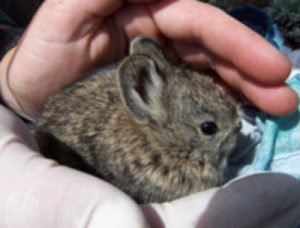 In mid-January, scientists from four universities will fly small, unmanned aircraft systems over sagebrush habitat near Magic Reservoir to obtain information about the habitat needs of pygmy rabbits. The pygmy rabbit has been considered for listing as an endangered species since 2003, when the Hailey-based Western Watersheds Project and several other conservation groups filed a petition with the U.S. Fish and Wildlife Service. In 2010, the agency rejected the petition on the grounds that it did not have enough data to decide whether the species warranted listing, but a spokesman told the Idaho Mountain Express at that time that the rabbits’ sagebrush habitat was clearly shrinking.
In mid-January, scientists from four universities will fly small, unmanned aircraft systems over sagebrush habitat near Magic Reservoir to obtain information about the habitat needs of pygmy rabbits. The pygmy rabbit has been considered for listing as an endangered species since 2003, when the Hailey-based Western Watersheds Project and several other conservation groups filed a petition with the U.S. Fish and Wildlife Service. In 2010, the agency rejected the petition on the grounds that it did not have enough data to decide whether the species warranted listing, but a spokesman told the Idaho Mountain Express at that time that the rabbits’ sagebrush habitat was clearly shrinking.
The U.S. Forest Service, the BLM and the University of Idaho have been jointly conducting research on pygmy rabbit habitat since 2003. According to a news release from the Salmon-Challis National Forest, pygmy rabbits are typically found in areas of tall, dense sagebrush cover, and are highly dependent on the plant to provide both food and shelter throughout the year. Their diet in the winter consists of up to 99 percent sagebrush.
For about two days beginning Jan. 13, small UAS carrying cameras will be guided over BLM-managed land west of state Highway 75 near Magic Reservoir. Those flights will follow similar flights from Jan. 6-10 in the Lemhi Valley near the town of Leadore.
According to the news release, the goal is to capture high-resolution digital images that measure concealment of rabbits from predators and quality of food provided by the sagebrush.
The robotic aircraft are hand-launched, weigh about 14 pounds and have a 7- to 9-foot wingspan. They fly parallel transects for 20-30 minutes at a time, and their cameras can capture a resolution of about 3 centimeters.
The work is part of a collaborative research programme conducted by the University of Idaho, Boise State University and Washington State University. The project aims to create maps of habitat quality that will be matched with patterns of use by the animals.
“I think it’s going to be really novel,” said Janet Rachlow, an associate professor of wildlife biology at the University of Idaho. “I think it has the ability to take a better approach to understanding habitat quality.”
Rachlow said the aircraft were used to take photos of summer habitat in June at both the Magic Reservoir and Lemhi Valley sites. She said matching those with the winter photos will allow biologists to better analyze the year-round needs of the rabbits.
Rachlow said the area around Magic Reservoir is good, intact pygmy rabbit habitat, and can provide a model for habitat rehabilitation projects elsewhere in the state. However, she said, to create successful projects, scientists need to know how the rabbits use their habitat, including what priorities they place on food, cover from predators and protection from heat and cold.
“The aerial images we get will help us scale up from what individual animals do to what the whole population does,” she said.
Rachlow said project scientists will follow up on the flights by spending the next two years taking measurements on the ground.
The UAS flights will be conducted by the University of Florida Unmanned Aircraft Systems Research Program. According to the Forest Service news release, the programme has received a certificate of authorization from the Federal Aviation Administration permitting low-altitude flights of small unmanned aircraft over unpopulated areas within one nautical mile of the ground-control station.
Rachlow said the flights will also provide scientists with more information about how robotic aircraft can be used for other types of research. For example, she said, the Idaho Department of Fish and Game would like to use this method to count salmon redds—or spawning nests—in rivers.
“A lot of biologists spend a lot of their time in small planes and helicopters,” she said, “and that’s dangerous.”
Scientists will give a presentation on the research at the Sacajawea Center in Salmon on Tuesday, Jan. 7, at 7 p.m. Researchers will give a short presentation about their work in the Lemhi Valley and about application of UAS technology for wildlife and natural resources. They will have the equipment for people to see, and will have several members of their team available to answer questions. The Sacajawea Center is two miles east of Salmon on state Highway 28.
Source: Idaho Mountain Express
